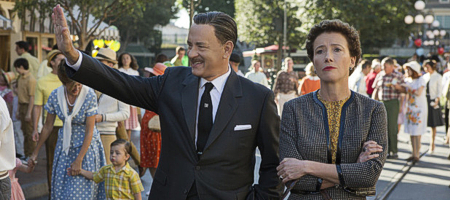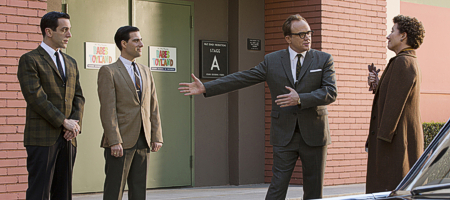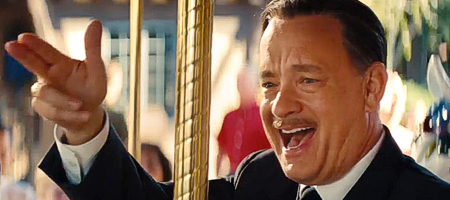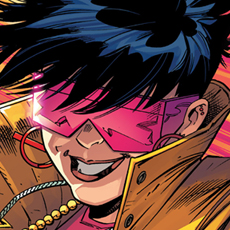 Although a huge spoonful of sugar helps some of the potentially darker and not-quite accurate elements go down, it is clear from the opening logo (a very nice but odd retro-melding of the 1980s blue castle Disney emblem combined with the text format of a 1940s cartoon title card that has the strange effect of suggesting “Walt Disney Presents”…!) that Saving Mr Banks – promoted as “the making of Mary Poppins” – has been made by filmmaking fans not only as a love letter to Poppins but to Uncle Walt as well.
Although a huge spoonful of sugar helps some of the potentially darker and not-quite accurate elements go down, it is clear from the opening logo (a very nice but odd retro-melding of the 1980s blue castle Disney emblem combined with the text format of a 1940s cartoon title card that has the strange effect of suggesting “Walt Disney Presents”…!) that Saving Mr Banks – promoted as “the making of Mary Poppins” – has been made by filmmaking fans not only as a love letter to Poppins but to Uncle Walt as well.
However, just as the recent Anthony Hopkins Hitchcock film was really more about Mrs Hitchcock and how the making Psycho affected her life during the shoot (and should have rightfully been called Mrs Hitchcock in terms of its emphasis), Saving Mr Banks is just if not more concerned with highlighting the early, formative years of Poppins author PL Travers’ life than just the making of Walt Disney’s screen version. The film continuously (and once or twice too repetitively) cuts between Travers’ journey to LA to meet Walt and her early life in Australia, where alcoholic Dad Colin Farrell (doing his best work in ages) descends into an unemployable mess. While these scenes work dramatically, they’re also a little heavy handed in setting up how supposed real-life influences would later emerge in the Poppins books (or, rather more, the eventual movie).
So various characters say things (“Spit-spot!”) or hint at phrases or elements (an aunt arrives with full Poppins-style carpet bag in tow) that will later show up in the film, implying that Travers really did use a lot of her experiences in her books (which I haven’t read) or that the Disney story crew were mind-readers able to tap into her innermost thoughts. They’re cute touches to be sure, and there’s quite a bit of connecting some dots in this fashion to tie things all together neatly, but it does work even if it does all feel a little too convenient, light and frothy. Bringing some gravitas is Emma Thompson as Travers, who isn’t nearly as short, plump or plain looking as the real author, although after a while I did find her performance to be a little one-note and, even when her steely demeanour breaks towards the end, it wasn’t quite as emotional as I thought it could have been played.
 The many flashbacks to her early life are interwoven variously either very well (with clever staging and editing between the two main settings) or not so smoothly accomplished, with one or two Australian segments seemingly placed slightly against the wrong “contemporary” LA scene. Sometimes what happens in a flashback mirrors or informs what Travers is going through in the film’s 1961 present and these edits can be very smart, if cute, but at other times it does feel like either the flashback or the present scene could have been shifted into each other’s place to a slightly better effect.
The many flashbacks to her early life are interwoven variously either very well (with clever staging and editing between the two main settings) or not so smoothly accomplished, with one or two Australian segments seemingly placed slightly against the wrong “contemporary” LA scene. Sometimes what happens in a flashback mirrors or informs what Travers is going through in the film’s 1961 present and these edits can be very smart, if cute, but at other times it does feel like either the flashback or the present scene could have been shifted into each other’s place to a slightly better effect.
Speaking of 1961, the film’s retro Hollywood setting is nicely achieved by way of costumes, sets and VFX. In the Animated Views Forum, I have already spoken about the revisionist-designed entrance to Walt Disney Productions as seen in Mr Banks‘ trailer, but I will mention again here that the Studio now has a much more nicely designed frontage than it had back then (the basic black rectangle “Walt Disney Productions” logo upon the side of a building is also seen, via an SFX shot I think, but when Travers first arrives in California and comes to Walt’s place, her car passes a lovely brick-designed signage that’s based on the much more recent 1980s Walt Disney Studios entrance wall).
This slight deviation from fact is more than forgivable if one assumes the filmmakers wanted to highlight Travers’ arrival at Disney’s to showcase a bit of self-importance on his part (something she believes Walt is full of), but slightly more of a no-no is when she is shown to her hotel room, strewn with Disney plush figures by way of a welcome. It’s played for, and gets, a big laugh…and the toys, especially a life-size Mickey Mouse figure, are largely and very appreciatively depicted as being exactly how they would have been in the 60s, in that they aren’t as well made, rounded or fluffy as today’s plush dolls…
…BUT – and get ready for a mini-rant that’s totally blowing things out of all proportion for the amount of screentime the following has! – buried within them is one of the film’s bigger anachronisms, and one I really wished had been stayed away from. (There are a few such anachronisms here, another possibly being a glimpse past a poster for a Disney film that didn’t come out much, much later, perhaps even after Walt’s passing.) For amongst the toys is clearly a fluffy Winnie The Pooh bear, a character that wouldn’t make his Disney screen debut for another five years (in 1966’s Honey Tree featurette). As the camera pans across the room I silently prayed that this Pooh plush might be glimpsed in this one wide shot and that would be it…something that could just about be overlooked in the spirit of the time.
Except that Travers focuses on it, picks it up, and laments what Walt has done to AA Milne’s character. I won’t spoil the her dialogue here, but the bottom line is that Travers – or anybody – wouldn’t have known what Walt might have done with Pooh yet: we’re in 1961, with Honey Tree not coming out until ’66, and there’s no way the public would have known how any development was going (if it was indeed even quite up and running at that point), let alone the suggestion that Walt would have already had soft-toys of the characters manufactured and available five years before an intended picture was due to be released.
Now…I do get why this was done and can totally understand that from either a writing or directing point of view, the filmmakers need to get across that Travers is fearful of what Disney will do to her creation. It’s clearly a shorthand line, for Travers to make a comment about another British author’s “treatment” at the American animator’s hand, and Pooh is an easy visual and instantly recognizable metaphor for this, as well as being of a similar timeframe. But with Walt’s adaptations of Alice In Wonderland and Peter Pan already released some years before – and therefore being something that Travers may well have seen and been familiar with as well as a modern audience – I wonder why a Disney consultant (or at least one doing their job properly) couldn’t have suggested a Pan or Alice figure instead…?
Each would have been a better and more authentic choice, highlighted the same point and could have possibly added more insight and depth to the moment: pick a Captain Hook plush and it might have also been indicative of Travers about to be “hooked” in under Disney’s charm…pick the Cheshire Cat and there might have been a hint of Travers about to disappear down the rabbit hole into the crazy world of Walt’s Wonderland… Most audiences won’t notice the Pooh snafu, but for a film that otherwise strives to perfect its depicted era and wanted to be as authentic and true to fact as possible, this seems a strange oversight to me.
 So, moving on…and the majority of the rest of the film is pretty much as you may have seen in the trailers. It’s light and frothy – Thomas Newman’s music helps the jazzy 60s zip by even if his score could have been lifted at times from the Finding Nemo soundtrack – and passes along without too much depth: Travers’ own unfortunate relationship with an adopted child isn’t mentioned (except for one glossed over referencing line) when it could have made for a further interesting parent/child angle, and although the 20-year struggle for Walt to get the Poppins rights is touched on in dialogue, you never see any early backstory from his side, which could have been nice, especially considering Diane Disney-Miller’s involvement with the film up to her very recent passing (it was Diane, along with her sister Sharon, that inspired Walt to go after Poppins in the first place).
So, moving on…and the majority of the rest of the film is pretty much as you may have seen in the trailers. It’s light and frothy – Thomas Newman’s music helps the jazzy 60s zip by even if his score could have been lifted at times from the Finding Nemo soundtrack – and passes along without too much depth: Travers’ own unfortunate relationship with an adopted child isn’t mentioned (except for one glossed over referencing line) when it could have made for a further interesting parent/child angle, and although the 20-year struggle for Walt to get the Poppins rights is touched on in dialogue, you never see any early backstory from his side, which could have been nice, especially considering Diane Disney-Miller’s involvement with the film up to her very recent passing (it was Diane, along with her sister Sharon, that inspired Walt to go after Poppins in the first place).
Personally, I couldn’t get past Tom Hanks as Walt Disney. Hanks portrays the old Mousetro well, and he certainly captures the essence of the role and even manages to grasp that unmistakable drawl occasionally, but for me the film is more about two powerhouse performances that almost rival the two significantly imposing people they are portraying onscreen. As Walt, Hanks is in supporting role mode, taking a back seat to the Poppins crew, including Jason Schwartzman as Richard Sherman, who is pretty darn fine here. I wasn’t quite so hot on BJ Novak as his brother, Robert, but this was more from a physical aspect as I found him too angular in the face (his performance, on the other hand, is just as spot on). Also good as Travers’ LA driver is Paul Giamatti, whose character is there to fill in some gaps and somewhat be the audience’s guide, helping to mellow out Travers as a presumably fictional character that crops up from time to time for her to bounce off.
But this is really Thompson’s film and although she is most successful in carrying the movie for most of its running time, her Travers isn’t really that much of a stretch past other things she has done, and I’m not sure that the intended anti-chemistry comes off with Hanks, rightfully promoted as a supporting actor. Slightly too young looking for the age Walt was at the time, this is more Tom Hanks slicking his hair back, growing a moustache and drawling his voice out a bit rather than him really inhabiting his character, and his eyes, to me, never quite said “Walt” even though what he does he does very well, especially when his efforts to secure the Poppins rights have failed and he makes one final plea to Travers (the genius of the film – and Walt – was that when Disneyland didn’t work its magic, he was able to convince her on her own ground), which is a moment worth seeing the movie for on its own.
However, by the film’s end, Saving Mr Banks somewhat concedes that it can’t beat the real thing, and falls back into showcasing some scenes and emotional beats borrowed from Poppins itself. The film isn’t about the “making of Mary Poppins” at all…Mr Banks is all set before a frame was shot or the cast was even set. It then jumps to the Poppins premiere (which Travers invited herself to), where some Julie Andrews and Dick Van Dyke lookielikes (the pair are never seen otherwise, apart from in the Poppins film sequences) pop up for a shot. The Andrews double is pretty good, but she is seen just before we see the real thing seconds later and one realizes she actually looks nothing like her, while the Van Dyke double is more like a younger Mickey Rooney: my feeling is that with the real actors about to be seen the premiere night coverage might have been better off just continuing to focusing on Travers’ bemusement at the whole spectacle.
In this ending, the film scenes from Mary Poppins are a little hit and miss in terms of effectiveness. On the one hand, it’s a bit of a cheat to rest back on classic nostalgia in a “new” movie, but on the other these moments celebrate the original film and champion this new one’s reason for being all-too-well (even if Poppins here begins without the Buena Vista fanfare that greeted the actual premiere audience in 1964). It’s a double-edged sword that perhaps shows too much real Poppins, but then doesn’t really show enough of the film’s sublime subplot to make the point that Saving Mr Banks‘ title really alludes to. In all this is a decent film that, while possibly a little overlong as all films are these days, doesn’t actually outstay its welcome and certainly works as a typically Disneyfied and fluffy version of events even when it’s overlooking some of the harder facts involved so as to paint a family-friendly portrait of Travers and Disney’s apparently jovial battle of wits.
 Thompson and Hanks are both good, even if I didn’t think they truly inhabit their characters apart from two or three moments each, and the film may have too light a touch to really win over Oscar voters (Travers’ early life looks hard, but it’s not traumatic enough; Travers in LA is depicted in comedic fish out of water fashion; Disney is portrayed as a smoker, but that’s about as dark as he gets), and it’ll be interesting to see if it can bounce back from its no-show in today’s Golden Globe nominations, where it was expected to be noted for its two stars, writers (Kelly Marcel and Sue Smith) and director, The Blind Side‘s John Lee Hancock. I was surprised the screenplay hasn’t been better noticed: for a long while sat on Hollywood’s infamous Black List, it was purchased by Disney as a way to prevent others from making it until head of production Sean Bailey suggested they actually did, and although sprinkled with fairy dust it’s well researched and crafted.
Thompson and Hanks are both good, even if I didn’t think they truly inhabit their characters apart from two or three moments each, and the film may have too light a touch to really win over Oscar voters (Travers’ early life looks hard, but it’s not traumatic enough; Travers in LA is depicted in comedic fish out of water fashion; Disney is portrayed as a smoker, but that’s about as dark as he gets), and it’ll be interesting to see if it can bounce back from its no-show in today’s Golden Globe nominations, where it was expected to be noted for its two stars, writers (Kelly Marcel and Sue Smith) and director, The Blind Side‘s John Lee Hancock. I was surprised the screenplay hasn’t been better noticed: for a long while sat on Hollywood’s infamous Black List, it was purchased by Disney as a way to prevent others from making it until head of production Sean Bailey suggested they actually did, and although sprinkled with fairy dust it’s well researched and crafted.
Longtime Disney fans will know what is coming, and will appreciate many little “Easter eggs” peppered throughout just as much as they will cringe at some things that aren’t quite so true or spit-spot (for instance, the origins of A Spoonful Of Sugar, oft-told by the film’s consultant Sherman but slightly appropriated here). The end is very good, and certainly the audience I saw it with appreciated the film overall and, a rarity, sat for the end credits which are worth sticking around for as they play some of the real Travers/Sherman Brothers tapes. Here we hear a little more about what Poppins means to Travers, but I might have preferred to hear the real versions of some of the more surprising lines in the movie, if they were indeed ever muttered: one has to remember this is ultimately a fictional account. But those tape snippets are authentic to hear, and remind us that however the movie has been fashioned, Travers’ trip to Disney’s did happen.
I’ll be interested to see how Saving Mr Banks does in release. It’s a much better and more genuine film than the somewhat similar Hitchcock, and although it’s been sold as the making of Poppins I don’t think too many will be put off by the actuality that this is a film that truly supports its title. It really is about the saving of Mr Banks, of Travers’ father in her mind, and the redemption that this figure goes through from real life to her written page and through Disney’s screen incarnation. It’s a film that, while it may not be “heavy” enough to warrant awards in major categories, manages to turn a series of events into an entertaining and strangely nostalgic picture that will surely do wonders in bringing people back to the original Mary Poppins, handily just out in a new 50th anniversary (actually the film’s 49th!) Blu-ray edition.
It’s been a fair few recent times that I’ve watched Poppins itself and figured out that she was there to save the children’s father all along, but Saving Mr Banks not only makes that whole aspect clear, but does so by way of creating a unique angle of its own. By using the Travers’ backstory as a hook, it becomes more than just the kind of TV-movie styled docudrama of the week that could have filled a gap as a DVD extra and stands both separately as its own accomplished achievement and as a lovely companion to a true screen masterpiece.
 | Saving Mr Banks Walt Disney Pictures December 13 (limited), 20 (wide) 2013 125 minutes Rated PG directed by John Lee Hancock | |



